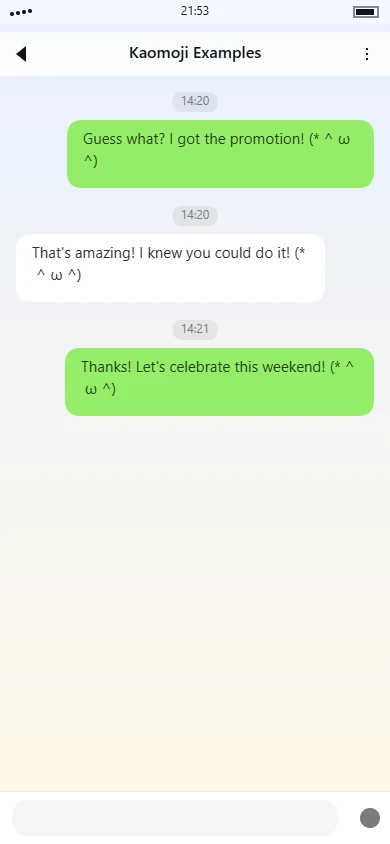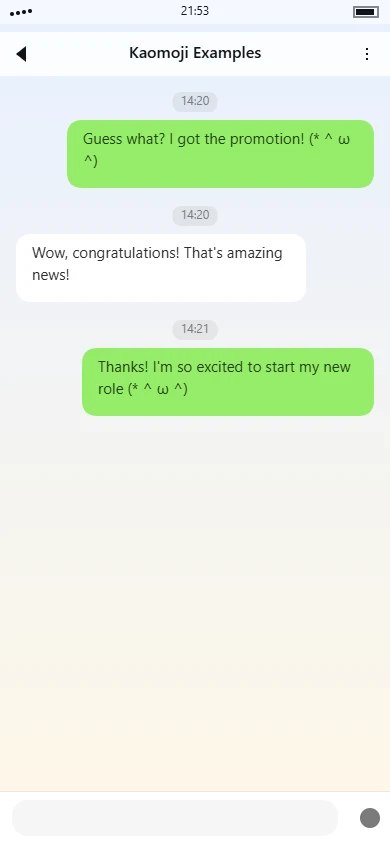<( ̄︶ ̄)> kaomoji Meaning | Usage Tips

Overview
The kaomoji <( ̄︶ ̄)> presents a stylized representation of a smiling face framed by hands. The overall structure consists of two main components: the facial expression in the center and the hand-like brackets on either side. This arrangement creates a balanced composition where the hands appear to be cupping or framing the face, adding a layer of physical expression to the emotional content.
Symbol Breakdown
- < and >: These angle brackets serve as the outer boundaries of the kaomoji, visually representing hands or arms that frame the face. Their angular shape suggests a more stylized, simplified hand gesture rather than a realistic depiction.
- ( ): The parentheses form the basic outline of the face, creating a rounded container for the facial features. This circular shape is a common convention in kaomoji design for representing a head or face.
-  ̄︶ ̄: This central sequence forms the actual facial expression. The two  ̄ characters (fullwidth macrons) serve as eyes, positioned horizontally and slightly elevated. The ︶ character (fullwidth low line) between them forms an upward-curving mouth, creating the smiling expression.
Emotion & Aesthetic Analysis
The emotional tone conveyed by <( ̄︶ ̄)> is one of contentment and mild satisfaction. The upward-curving mouth (︶) creates a gentle smile that suggests happiness without being overly exuberant. The horizontal eye lines ( ̄) contribute to a relaxed, calm expression rather than wide-eyed excitement.
The framing hands (< and >) add a significant dimension to the emotional expression. They suggest the character is touching their own face, which can convey various nuanced meanings depending on context: self-satisfaction, contemplation, or a gesture of mild surprise or delight. This physical element makes the expression more active and embodied compared to simple face-only kaomoji.
Compared to similar smiling kaomoji, <( ̄︶ ̄)> occupies a middle ground between the subtle (^_^) and the more exaggerated (≧▽≦). The hands provide additional expressiveness without overwhelming the facial expression itself. The overall effect is balanced and moderately expressive, suitable for conveying general satisfaction, agreement, or pleasant acknowledgment in digital communication.
The character choices reflect a preference for fullwidth characters, which provide better visual balance and spacing in many text environments. The combination of Japanese fullwidth punctuation and symbols creates a cohesive visual unit that reads clearly as a single expressive entity rather than random characters.
Tag categories
Use tags to quickly understand this kaomoji.
Style tags
Expression tags
Click tags to explore related kaomoji.
Usage guide
Usage Guide for <( ̄︶ ̄)>
The kaomoji <( ̄︶ ̄)> is a classic and versatile emoticon that captures a content, self-satisfied expression—often resembling someone with closed eyes and a gentle, confident smile. It's widely used in casual online communication to convey feelings of accomplishment, quiet pride, or relaxed happiness without being overly exuberant. You'll often see it in chat messages, social media comments, and gaming communities where users want to express a sense of achievement, approval, or lighthearted confidence. Its tone is generally warm and positive, making it suitable for friendly exchanges, but it can also carry a subtle hint of playful smugness depending on the context.
Use Cases
- Reacting to a personal achievement, like finishing a project or winning a game.
- Expressing quiet satisfaction when someone compliments your work or idea.
- Adding a friendly tone to a message where you're agreeing with a friend's opinion.
- Celebrating small victories in group chats, such as completing a daily goal.
- Responding to good news from others to show you're genuinely happy for them.
- Using in online gaming after a well-executed move or team success.
- Posting in social media captions to highlight a moment of personal contentment.
- Replying to a joke or funny meme to indicate you find it clever or amusing.
- Signaling approval in community forums or discussion threads.
- Lightening up a conversation when sharing a positive update about your day.
Examples
- Friend chat: "Just aced that exam I was stressing about! <( ̄︶ ̄)>"
- Gaming group: "We finally beat the boss on the first try—great teamwork, everyone! <( ̄︶ ̄)>"
- Social media comment: "Loving the new recipe you shared—turned out perfectly! <( ̄︶ ̄)>"
- Casual message to a colleague: "Thanks for the feedback; I'm glad the presentation went smoothly. <( ̄︶ ̄)>"
- Reply in a community thread: "That solution worked like a charm. Appreciate the help! <( ̄︶ ̄)>"
Notes
- Avoid using this kaomoji in formal or professional settings, such as business emails or serious discussions, as its casual tone might seem unprofessional.
- Be mindful that in some contexts, the expression could be misinterpreted as slightly smug or self-satisfied, so use it with people who understand your communicative style.
- While it's generally positive, overusing it might dilute its impact or come across as repetitive in longer conversations.
This emoticon is especially popular in East Asian online cultures but has gained global recognition through platforms like Discord, Twitter, and gaming communities. It works well in text-based chats where a subtle, non-verbal cue can enhance the emotional tone without needing elaborate explanations.
Usage examples
Real conversation samples that feature this kaomoji.

Example 1

Example 2
Related kaomoji
You might also enjoy these kaomoji.